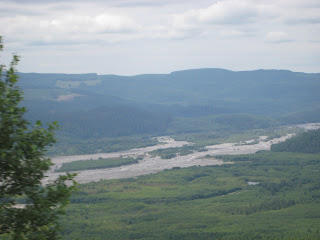The first stop she suggested was what she called the 7 Wonders Museum. She said it was a tiny little place but said they had lots of pictures. So armed with that information, we headed towards Mount St. Helens. When we spotted the museum, we thought there had been a mistake. There was a sign for the 7 Wonders Museum, but it looked like a house. Upon driving into the little parking lot, we saw a smaller dwelling behind the house with a sign that said "Open." We hesitantly got out of the car to check things out. As soon as we stepped onto the sidewalk, an older gentleman walked out of the museum with a huge grin on his face and a resounding "Welcome" in his voice. He started by showing us a commissioned painting on his garage wall of Mount St. Helens.
 |
| 7 Wonders Museum |
Emilee is participating in one of the
hands-on experiments.
I loved all of the 7 Wonders Museum, but my favorite part came when we wondered into their back room. It was set up with some books for sale lining the wall along with chairs set up in a meeting style format - almost like a small church. And over in the corner we spotted an old upright piano. Now if you know Ashlee's piano teacher (Mrs. Queen), you know that she sent her off on vacation armed with piano music and told Ashlee to do what she had to do to put her fingers on a piano along the way so they wouldn't have to backtrack too much when we got back to town. I walked over to the piano, and there was a sign on it. Since it was an old piano, I assumed it was going to say, "Please Don't Touch." Much to my surprise, the sign read as follows...
To practice on while on vacation? NO WAY! So since we were the only ones there, off I went to ask if Ashlee could practice. I told him we saw the sign on the piano, explained our situation, and proceeded to ask if Ashlee could practice. He was thrilled. Then he told me that the piano had been in there for years and that his wife had just put that sign up THREE DAYS AGO! Again, NO WAY! So Ashlee went to get her music and had a nice practice session. Mrs. Queen will be thrilled!
 |
| Practice makes perfect |
We finished up at the museum, left a donation, of course, and headed off toward Mount St. Helen. One of the other stops along the way that the visitor center recommended was the buried A-frame house and Big Foot. While not nearly as amusing as the 7 Wonders Museum, it still provided a fun photo opp. Prior to the eruption, the A-frame house was under construction and was three days from being completed on the day Mount St. Helens erupted. It was buried by mud flow at around 5:00 pm, approximately 8.5 hours after the eruption. Approximately 200 tons of silt, mud, water and ash filled up the structure.
Based on signage beside Big Foot,
we couldn't figure out its relation to the eruption.
Enough detours. We loaded back up and we went on to the Mount St. Helens visitor center. They had an overlook, so we grabbed a few pictures from there of the river bed created by the flow.
Since it was a cloudy day, we didn't have a clear view of the top of Mount St. Helens, but the view from the overlook was still amazing.
This is one of the trees that was blown by the blast.
It is still embedded into the ground.


After leaving Mount St. Helens, we headed off to our stop in Port Angeles, Washington. On our way there, it happened again. Snap, crackle, pop... this time with the emphasis on crack! Scott was driving down the interstate, and it was raining. We heard a rock hit the window but, since it was raining, I couldn't see any damage. As we were pulling into the restaurant for dinner, I spotted the crack. This time it wasn't a bullet type hit. A crack started at the passenger's side edge of the windshield, and shot about five inches toward the driver's side. Thank goodness we hadn't yet replaced the windshield from the first hit. At the time of this writing, the crack has snaked its way all the way from one side to the other. We're hoping to wait until we get home to replace it. With 7000 miles logged on the van since the beginning of our trip and with at least 4000 more to go, you just never know when it's going to happen again. Fortunately, we can laugh about it and say it could have been a whole lot worse.
















No comments:
Post a Comment